WHEN he recently noticed many of the thousands of newly planted trees in the new Glas-na-Bradan forest on the Belfast Hills pulled up and broken, Woodland Trust director Ian McCurley was left scratching his head.
It was hardly vandalism – not up here on this remote, windswept hillside overlooking Belfast.
And the trees had been planted by hundreds of members of the public excited by the plans to reforest the land and who heeded the call to help out for free. Even Dúlra did his bit – planting a wee holly last year that he hopes will some day provide thick cover to all those brilliant mountain birds which will flock there in years to come.
The damage to the saplings was baffling, but Ian soon found the culprit: the mountain hares. “The strange thing is that they are just pulling them out of the ground, not even eating them,” Ian told Dúlra during a dander on the hillside this week.
Hares are animals of open grassland, of course, so the future forest will evict them from the open hillside which they now live on. Could that be the reason for the wanton destruction? Could these wily Irish hares be far-sighted enough to kill off trees in order to protect their realm?
Whatever the reason, Ian’s philosophical enough not to complain. “The hares were here before us,” he told Dúlra, “it’s their hill.”
But they won’t win – Ian and his team are constantly replacing the ripped out trees with new ones.
“We don’t use stakes or plastic to protect the newly planted trees. It’s all natural. Eventually they will grow too big for the hares to damage,” he said.
Glas-na-Bradan is three years into a five-year planting scheme. By 2025, 150,000 trees will adorn this once-forgotten hillside behind and above St Enda’s GAC Glengormley.
In 2021, the Woodland Trust bought it off a farmer who lived in Glenarm. “He used to travel here in his tractor to work – you can imagine the queue of traffic behind him!” Ian laughed. And with the purchase, the vision of a forest became a reality.
“It will connect with the Cave Hill Country Park – connectivity on the Belfast hills is very important.”
A total of 15 native Irish species have been planted – trees like willow, alder and birch.
Dúlra never got round to asking Ian if holly was one of them – maybe the one he planted will be unique. If it is, he’ll have no problem finding it when the forest matures. Dúlra’s holly was grown from a berry found on Black Mountain – which means its ‘provenance’ is excellent. That’s a key word in Ian’s vocabulary, because for forestry experts like him, it’s important that the trees they plant come from local seeds – and the nearer the better. It’s believed that the trees that grow, for example, on the Belfast Hills will have developed small differences to suit that micro-climate.
We can’t source 150,000 new trees as local as that, but all those planted at Glas-na-Bradan have come from Irish seeds. (When people talk about how Brexit is making it difficult to import trees from Britain, that’s actually a positive thing!) Demand for Irish trees is outstripping supply in a country which is desperately lacking in tree cover compared to its European neighbours.
“If anyone wants to set up a tree nursery, now’s the time to do it,” Ian said.
Glas-na-Bradan is lucky to have Ian as a guardian, because there’s not much about trees he doesn’t know. He took a degree in forestry in Wales and then went to California to do a Masters in Wood Science, Technology and Forestry at the famous Berkeley University.
It’s a long way from sunny California to the bleak Belfast Hills in November – where Dúlra and Ian got drenched on our walk – but Ian has no regrets. This project has been a great success so far and there are two more years to go. “Locals have bought into it – it’s heartwarming,” Ian said. “There are more planting events in January and February next year if people want to be part of it.”
It should be even colder then, but Dúlra has no doubt that there will be plenty of volunteers willing to climb Glas-na-Bradan to help Ian and the Woodland Trust realise their vision of a native broadleaf forest on the Belfast hills.
• If you’ve seen or photographed anything interesting, or have any nature questions, you can text Dúlra on 07801 414804.





